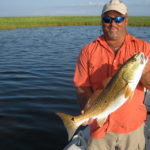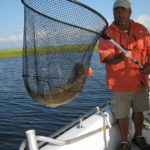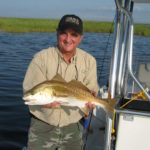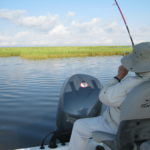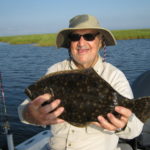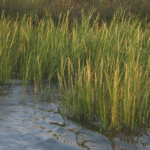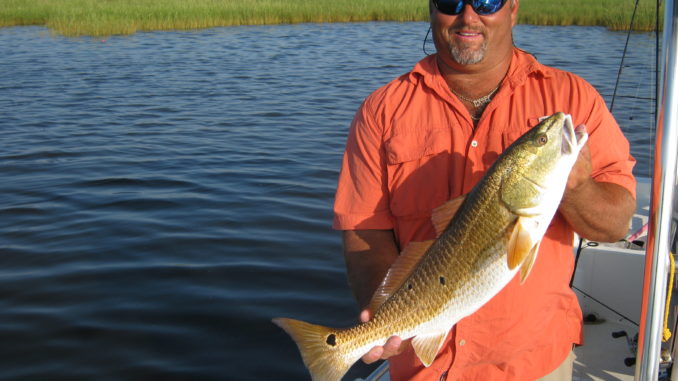
Reds are the main attraction, and specks round out the ticket at this St. Bernard Parish hotspot.
It didn’t take much arm-twisting to persuade Casey Kieff (504-512-7171) to take me and a couple buddies on a quick trip to fish Magnolia Lagoon. The lagoon is a 15- or 20-minute boat ride out of either Shell Beach or Hopedale, and is well known for holding two things in abundance — redfish and stumps.
It’s long been on my short list of places I wanted to fish, and this season, when the trout got a bit scarce there for a while, Magnolia Lagoon shot up to the very top of my list. It was during one of those strange spells we go through every now and then when the speckled trout pull a vanishing act or develop a severe case of lockjaw and redfish become the main object of pursuit.
I’d just made another less-than-productive trout trip, and decided to call Kieff and pretty much insist he take me to catch some reds. Kieff agreed to take me and to captain my boat for the trip, so a couple buddies and I left out of Shell Beach in the 24-foot Skeeter Bay with Kieff at the helm just as the sun peeked over the horizon.
At the time, the weather was moderate, the tides were high and falling all morning, and the winds were predicted to be only 8-12 from the southeast. Kieff likes to fish a wind from the east in that area, whether southeast, northeast or east, as long as it’s not blowing too hard. West winds, especially anything over 12-15 mph, is bad for fishing that side.
We crossed the MRGO and ran straight into Lake Borgne, and Kieff put a bead on Bayou St. Malo. From there, we took the meandering bayou into Magnolia Lagoon, a two-mile long stretch of water known to hold redfish along its broken shoreline, marsh islands and hidden stumps. According to Kieff, the water averages three to four feet throughout the length of the lagoon, and it usually stays pretty clear under most conditions.
“The one thing that’ll mess it up is a strong, steady west wind,” he said. “If it’s mild or moderate from the west, it’s no problem, but wherever the water is shallow over here, a strong west wind will push the water out of the marsh and dirty it all up, and that will shut down the action.
“The good thing is once the winds lay down, it’ll clear up in there pretty fast.”
Once we entered the big lagoon, Kieff slowed the boat to almost idle speed.
“The bottom of Magnolia is littered with big stumps that’ll tear up props and lower units, punch holes in your hull and ruin your day,” he said. “I see guys with flatboats running in here on high tides, and usually they can get away with it unless they hit a floating log, and they have some of them in here.
“But bay boats should never run in here, even on high tide. Either idle or use your trolling motor throughout the entire length of the lagoon.”
Naturally, on days with lower-than-usual tides you’ll want to be extra cautious, and on extremely low tides stay out altogether.
“On those days, it’s usually real cold and you wouldn’t want to fish up in here anyway,” Kieff said.
After a few minutes of slow motoring, Kieff stopped where it would take a long cast to reach the bank. We were off a point where some current was moving, and I stuck the Cajun anchor. The plan was to soak a live shrimp under a popping cork up near the shoreline, and we didn’t have to wait long for the action to begin. A nice red inhaled my shrimp and protested the pull of the hook all the way back to the boat.
“Generally I’d say you want to give a spot at least 15 minutes to produce,” Kieff said. “You want to remember the water is shallow here so just by approaching you stir things up and can scatter the fish. So you have to give it time to settle down and let the fish get back to the business of finding your bait.
“But don’t sit in one spot all morning if you’re not getting bites. If I don’t have any hits after 15 minutes or so, I’m moving. Troll or motor down to the next likely spot, and try again. The other option is to keep trolling, and you can cast live baits — minnows, cocahoes or shrimp — dead shrimp or soft plastics like beetles, DOAs or Gulps, under a cork, or gold spoons, beetle-spins and even topwater baits. They’ll all work. And when you get a hit, put the Cajun anchor or Power Pole down.”
We caught several nice reds in that one spot before the action played out. Kieff moved us about 50 yards down the shoreline, and we tried again. Once again, within 10 minutes or so we got nailed by hungry reds and added a few more to our collection. We followed that same procedure over the course of the morning — moving, sticking, fishing. At a few places we caught nothing. But at others we caught reds and even the occasional trout.
“Oh yes, the trout do get in here, sometimes in pretty good numbers and sizes,” Kieff said. “We catch them off the points and sometimes in the middle.
“If I see signs of bait, I’ll sometimes drift right in the middle of Magnolia and cast live shrimp under a cork, just like you’d do in a bigger lake like Amedee. And if you start catching fish, stick there and see if the action continues. If not, keep drifting or go back and re-drift the same area. Just remember, you have to move slow, even in the middle.”
Besides Magnolia Lagoon itself, there are three areas nearby that will usually hold fish, especially on those days when Magnolia is unfishable.
The three bayous
“On the days when the tides are too low to get into Magnolia, fish the bayous and canals nearby,” Kieff advised. “Look for the deeper holes in the turns or fish at drains cuts and points.
“Whenever the tides are low, the fish will get in these canals and stack up in good numbers, both trout and redfish. Don’t anchor in the middle. The water is generally 5 to 6 feet deep in these canals, but you want to get your boat anchored up near the bank so you can throw out in the middle and fish on the bottom, and also you can cast parallel along the shore, so your bait can dribble down the ledges. This area is mostly bottom fishing, either soft plastics or live cocahoes on a jig head, or a Carolina rig with live shrimp or a minnow, but you can try under a cork also. We often catch some flounder in here also.”
Stump Lagoon
On the more moderate days, if trout are more to your liking, Kieff suggests you run Bayou Loutre over into Stump Lagoon and head to the north side, from Mack’s Pass and over to the west. He says you’ll catch reds and specks, best fished under a cork, and you’ll want to anchor in that area to fish it.
“When the conditions are right, this area will be productive, and boats tend to line up in there, so drifting and trolling isn’t really an option,” he said. “Find a point, cut or cove, and give it 15 minutes.
“Some anglers like to move farther west into what we call ‘Little Stump,’ but it’s shallow and full of stumps, so you’ll want to move slow and cautious through it, and stay out altogether on low-water conditions.”
Mussel Bay
The next hotspot from there if you continue north is the pass at Mussel Bay. Kieff says the pass is deeper, between 8 to 10 feet, and redfish tend to hang along the bottom. He says you can also try under a cork because trout will roam through there as well, but it’s mainly known as a redfish hangout.
“Just north from there is the bayou at the top of Mussel Bay,” he said. “It’s 7 or 8 feet deep in there, and you can catch both trout and reds.
“Fish the bottom and under a cork. You can either anchor off a point or along the bank, and fish the drops and ledges.”
Pete’s Lagoon
Kieff likes two areas in particular in Pete’s Lagoon.
“When you first enter it, there’s a bunch of small marsh islands and reefs,” he said. “The water is pretty shallow, about 3 to 4 feet deep, so you’ll want to fish under a cork.
“I like to anchor off an island or by the north shoreline, and cast all around the boat. You’ll mostly catch trout in Pete’s, but reds show up, too. Live bait is always a plus, but plastics will also produce.”
Kieff says the other option in Pete’s is to drift the middle and fish under a cork, and stick your Cajun anchor if you find some trout.
Cut Off
“You fish Cut Off the same way you fish Pete’s, under a cork, and focus on the islands, points and passes,” he said. “Anchor and cast all around; give a spot 15 minutes, and move until you find them.
“Cut Off is a little deeper than Pete’s, averaging 3 to 5 feet, and all of these areas get productive in the late fall and early winter, unless it gets frigid.”
Meanwhile, we continued to fish up and down along the length of Magnolia, concentrating on the redfish that make the area home. I saw one of the huge floating logs that hide in ambush, ready to sabotage unwary boaters, and we bumped a stump or two over the course of the morning.
And we wailed on the redfish. Many anglers won’t even consider fishing Magnolia because of the stumps, but if you move slowly and watch for obvious logs, you should be able to fish it without a problem as long as the tides are not low. Now that I know how to fish it, I’ll be back. The reds are just too tempting to stay out.
Capt. Casey Kieff can be reached at (504) 512-7171.
Destination Information
HOW TO GET THERE — Anglers intending to fish the Magnolia or Stump Lagoon area usually launch from either Hopedale or Shell Beach. Both are about an hour’s drive from Downtown New Orleans.
Directions: Take I-10 east, and exit on I-510 south (Chalmette/Paris Road). Turn left on Highway 39 (Judge Perez Drive), and follow it to the four-lane intersection just before the intersection with Highway 46. Turn left on the four-lane, and follow it all the way to the four-way stop. Turn left at the stop sign, cross the Yscloskey bridge, and take a right to Hopedale or a left to Shell Beach.
MARINAS — Breton Sound Marina has a hoist, a double backdown, ice, live bait, accessories and a nearby fuel dock. The old Pip’s Place Marina is closed, but a few anglers still use the backdown, though the ramp is very steep and it is unadvisable to launch there.
Campo’s is open in Shell Beach, offering a double backdown, live bait, ice, fuel and some accessories.
MAPS — Standard Aerial Map No. 304.
